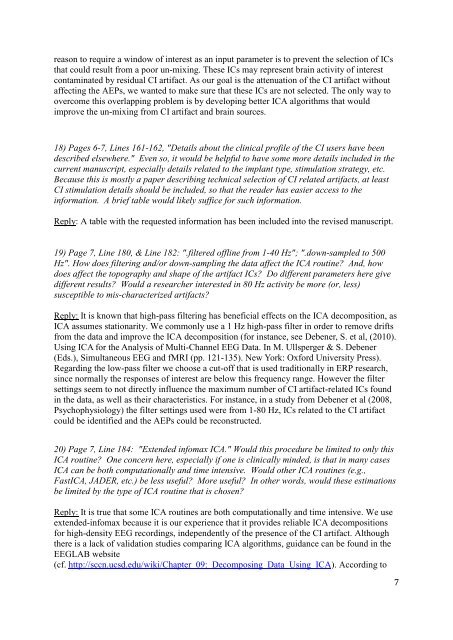Elsevier Editorial System(tm) for Hearing Research Manuscript Draft ...
Elsevier Editorial System(tm) for Hearing Research Manuscript Draft ...
Elsevier Editorial System(tm) for Hearing Research Manuscript Draft ...
You also want an ePaper? Increase the reach of your titles
YUMPU automatically turns print PDFs into web optimized ePapers that Google loves.
eason to require a window of interest as an input parameter is to prevent the selection of ICs<br />
that could result from a poor un-mixing. These ICs may represent brain activity of interest<br />
contaminated by residual CI artifact. As our goal is the attenuation of the CI artifact without<br />
affecting the AEPs, we wanted to make sure that these ICs are not selected. The only way to<br />
overcome this overlapping problem is by developing better ICA algorithms that would<br />
improve the un-mixing from CI artifact and brain sources.<br />
18) Pages 6-7, Lines 161-162, "Details about the clinical profile of the CI users have been<br />
described elsewhere." Even so, it would be helpful to have some more details included in the<br />
current manuscript, especially details related to the implant type, stimulation strategy, etc.<br />
Because this is mostly a paper describing technical selection of CI related artifacts, at least<br />
CI stimulation details should be included, so that the reader has easier access to the<br />
in<strong>for</strong>mation. A brief table would likely suffice <strong>for</strong> such in<strong>for</strong>mation.<br />
Reply: A table with the requested in<strong>for</strong>mation has been included into the revised manuscript.<br />
19) Page 7, Line 180, & Line 182: ".filtered offline from 1-40 Hz"; ".down-sampled to 500<br />
Hz". How does filtering and/or down-sampling the data affect the ICA routine? And, how<br />
does affect the topography and shape of the artifact ICs? Do different parameters here give<br />
different results? Would a researcher interested in 80 Hz activity be more (or, less)<br />
susceptible to mis-characterized artifacts?<br />
Reply: It is known that high-pass filtering has beneficial effects on the ICA decomposition, as<br />
ICA assumes stationarity. We commonly use a 1 Hz high-pass filter in order to remove drifts<br />
from the data and improve the ICA decomposition (<strong>for</strong> instance, see Debener, S. et al, (2010).<br />
Using ICA <strong>for</strong> the Analysis of Multi-Channel EEG Data. In M. Ullsperger & S. Debener<br />
(Eds.), Simultaneous EEG and fMRI (pp. 121-135). New York: Ox<strong>for</strong>d University Press).<br />
Regarding the low-pass filter we choose a cut-off that is used traditionally in ERP research,<br />
since normally the responses of interest are below this frequency range. However the filter<br />
settings seem to not directly influence the maximum number of CI artifact-related ICs found<br />
in the data, as well as their characteristics. For instance, in a study from Debener et al (2008,<br />
Psychophysiology) the filter settings used were from 1-80 Hz, ICs related to the CI artifact<br />
could be identified and the AEPs could be reconstructed.<br />
20) Page 7, Line 184: "Extended infomax ICA." Would this procedure be limited to only this<br />
ICA routine? One concern here, especially if one is clinically minded, is that in many cases<br />
ICA can be both computationally and time intensive. Would other ICA routines (e.g.,<br />
FastICA, JADER, etc.) be less useful? More useful? In other words, would these estimations<br />
be limited by the type of ICA routine that is chosen?<br />
Reply: It is true that some ICA routines are both computationally and time intensive. We use<br />
extended-infomax because it is our experience that it provides reliable ICA decompositions<br />
<strong>for</strong> high-density EEG recordings, independently of the presence of the CI artifact. Although<br />
there is a lack of validation studies comparing ICA algorithms, guidance can be found in the<br />
EEGLAB website<br />
(cf. http://sccn.ucsd.edu/wiki/Chapter_09:_Decomposing_Data_Using_ICA). According to<br />
7
















